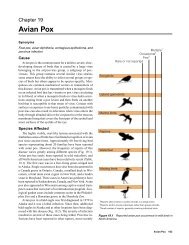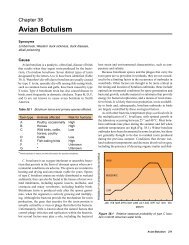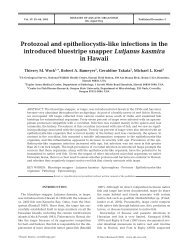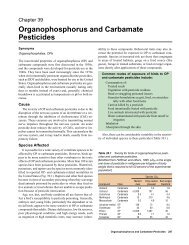Biowarfare, Bioterrorism, and Animal Diseases as Bioweapons
Biowarfare, Bioterrorism, and Animal Diseases as Bioweapons
Biowarfare, Bioterrorism, and Animal Diseases as Bioweapons
Create successful ePaper yourself
Turn your PDF publications into a flip-book with our unique Google optimized e-Paper software.
A single c<strong>as</strong>e of a high profile dise<strong>as</strong>e (e.g., BSE) or<br />
a small number of c<strong>as</strong>es of more common dise<strong>as</strong>es (e.g.,<br />
Newc<strong>as</strong>tle dise<strong>as</strong>e or bovine tuberculosis) may result in<br />
international sanctions that cause major economic losses for<br />
agriculture <strong>and</strong> related industries. The connectivity between<br />
many dise<strong>as</strong>es of animals <strong>and</strong> humans suggests the need<br />
for integrated preparedness for addressing the potential for<br />
bioterrorism attacks against animals. The 2001 outbreak of<br />
foot-<strong>and</strong>-mouth dise<strong>as</strong>e (FMD) in Europe is somber testimony<br />
to the costs that can be incurred by agriculture from<br />
the introduction of a highly contagious dise<strong>as</strong>e. More than 6<br />
million animals were slaughtered to combat this dise<strong>as</strong>e. 209<br />
Predicted costs from an FMD outbreak in California alone<br />
are at le<strong>as</strong>t $13.5 billion. 210<br />
Pacific<br />
Ocean<br />
EXPLANATION<br />
USA<br />
Era, country <strong>and</strong> dise<strong>as</strong>e species<br />
WW1<br />
USA* (horses, mules)<br />
Romania (horses, sheep, livestock)<br />
Spain (horses, cattle)<br />
Norway (reindeer, cattle)<br />
France (horses)<br />
Atlantic<br />
Ocean<br />
France<br />
Spain<br />
Norway<br />
Zimbabwe<br />
Romania<br />
Kenya<br />
1952<br />
Kenya (cattle)<br />
1978–80<br />
Rhodesia (cattle) (now Zimbabwe)<br />
1982–84<br />
Afghanistan (horses)<br />
248 Dise<strong>as</strong>e Emergence <strong>and</strong> Resurgence: The Wildlife–Human Connection<br />
“Double Agents”<br />
Pathogens that can cause dise<strong>as</strong>e in humans <strong>and</strong> animals<br />
can be viewed <strong>as</strong> “double agents” relative to the populations<br />
they can impact. Although the historic use of biological<br />
agents in wartime appears to have been specifically focused<br />
on either human or animal targets, most of the early uses of<br />
microbes <strong>as</strong> bioweapons involved agents capable of causing<br />
serious dise<strong>as</strong>e in both (Table 6.1). The interfaces between<br />
humans <strong>and</strong> animals can promote persistence <strong>and</strong> spread of<br />
infectious agents. Thus, careful selection of target situations<br />
can enhance the probabilities for dise<strong>as</strong>e in both humans<br />
<strong>and</strong> animals, <strong>and</strong> incre<strong>as</strong>e the potential for environmental<br />
persistence of the dise<strong>as</strong>e agent <strong>and</strong> dise<strong>as</strong>e spread through<br />
animal movements.<br />
Afghanistan<br />
Indian<br />
Ocean<br />
Gl<strong>and</strong>ers<br />
Anthrax<br />
Plant toxin<br />
* Maryl<strong>and</strong>, Virginia, <strong>and</strong><br />
New York area<br />
Figure 6.4 Documented war time uses of biological weapons to target livestock (developed from Wilson et al. 110 ).<br />
Pacific<br />
Ocean

















